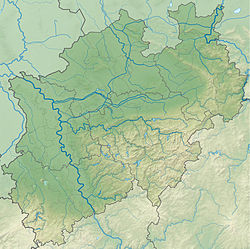This article needs additional citations for verification .(September 2014) |
| Old Synagogue | |
|---|---|
German: Alte Synagoge | |
 Postcard of the former synagogue, c. 1925 | |
| Religion | |
| Affiliation | Judaism (former) |
| Ecclesiastical or organisational status | Synagogue (1900–1933) |
| Status | Destroyed |
| Location | |
| Location | Dortmund, North Rhine-Westphalia |
| Country | Germany |
Location of the destroyed synagogue in North Rhine-Westphalia | |
| Coordinates | 51°30′39″N7°27′42″E / 51.5108°N 7.4617°E |
| Architecture | |
| Completed | 1900 |
| Demolished | December 1938; (following Kristallnacht ) |
| Capacity | 1,300 seats |
The Old Synagogue (German : Alte Synagoge) was a former Jewish congregation and synagogue, located in Dortmund, in the state of North Rhine-Westphalia, Germany. Completed in 1900, the synagogue was abandoned in 1933 and demolished in 1938. Prior to its abandonment, the synagogue was the largest synagogue and cultural center of the Jewish community in Dortmund.
